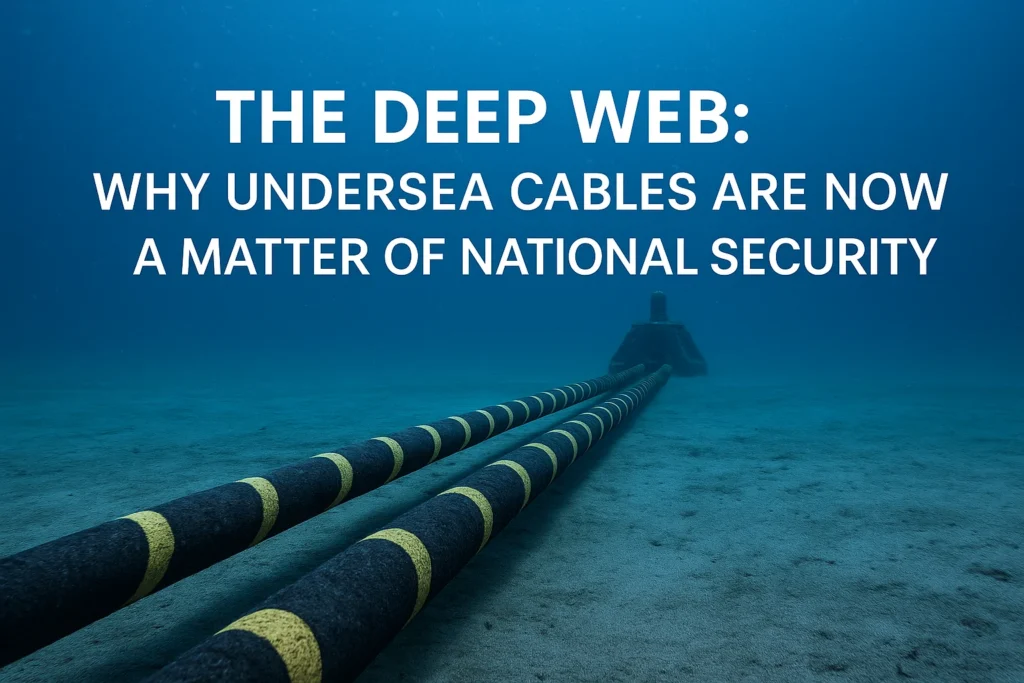Introduction: The Fragile Foundations of Digital Civilization
On the morning of January 15, 2022, the Hunga Tonga-Hunga Ha’apai volcanic eruption created a seismic event that would reveal the startling fragility of our global digital infrastructure. As the underwater volcano erupted with the force of hundreds of Hiroshima bombs, it generated shockwaves that traveled through the ocean at speeds exceeding 1,000 km/h. Within minutes, these shockwaves found their target—the 872-kilometer Tonga Cable System, the island nation’s sole fiber-optic connection to the global internet.
The cable’s rupture plunged Tonga into complete digital isolation. International calls failed. Financial transactions froze. Emergency communications ceased. For five agonizing days, this modern nation of 100,000 people existed in a state of digital darkness unseen since the pre-internet era. The Tonga disaster served as a wake-up call to governments and corporations worldwide—our hyperconnected civilization rests upon fragile strands of glass no thicker than a human hair, lying vulnerable on the ocean floor.
This incident marked a turning point in global awareness about undersea communications cables. What was once obscure infrastructure known only to telecom engineers has become recognized as critical national security assets—the submerged battlefields of 21st-century geopolitics. Today, these cables carry over 97% of global communications and $10 trillion in daily financial transactions, making them the central nervous system of the digital age.
Chapter 1: The Evolution of Undersea Cable Technology
From Telegraph to Terabits: A Historical Perspective
The story of undersea cables begins in 1850, when the first submarine telegraph cable was laid across the English Channel. This primitive copper wire could transmit just a few words per minute—a far cry from today’s fiber-optic behemoths carrying entire libraries of data each second. The evolution of this technology mirrors the broader arc of human technological progress:
First Generation (1850-1956): Copper telegraph and telephone cables
- Maximum capacity: 36 simultaneous phone calls
- Vulnerable to corrosion and electrical interference
- Required signal boosters every 50-100km
Second Generation (1956-1988): Coaxial copper cables
- Increased capacity to 1,800 phone circuits
- Introduced underwater repeaters
- Still limited by electrical transmission physics
Third Generation (1988-Present): Fiber-optic cables
- First transatlantic fiber cable (TAT-8) in 1988
- Uses light pulses through glass fibers
- Current capacity exceeds 200 terabits per second
The Anatomy of a Modern Undersea Cable
Today’s undersea cables represent one of humanity’s most remarkable engineering achievements. A cross-section reveals multiple protective layers:
- Optical Fiber Core: 4-8 pairs of hair-thin glass fibers (diameter: 0.125mm)
- Protective Coating: Silicone gel and copper tubing to prevent water intrusion
- Strength Members: Steel wires providing tensile strength
- Insulation Layers: Multiple polyethylene and aluminum barriers
- Armor Plating: Steel tape for protection against fishing gear and anchors
Despite this robust construction, the entire cable remains remarkably slender—typically 17-25mm in diameter, about the size of a garden hose. This delicate appearance belies its incredible durability, with most cables designed to withstand the immense pressures found at ocean depths of 8,000 meters or more.
The Global Cable Network: By the Numbers
As of 2024, the undersea cable network comprises:
- 486 active cables spanning approximately 1.3 million kilometers
- 1,245 landing stations connecting to terrestrial networks
- $15 billion annual investment in new cable projects
- 400+ terabits per second capacity on major routes
This infrastructure forms an intricate web connecting every continent except Antarctica. The network’s growth has been exponential—while it took 150 years to lay the first 1 million kilometers of cable, the second million was added in just the last 15 years.
Chapter 2: The New Geopolitics of Undersea Infrastructure
The Strategic Value of Cable Control
Undersea cables have become the digital equivalent of strategic waterways like the Strait of Hormuz or the Panama Canal. Their control offers nations:
- Economic Leverage: Ability to monitor or restrict financial data flows
- Intelligence Advantages: Potential for data interception and surveillance
- Military Superiority: Capacity to disrupt adversaries’ communications
- Diplomatic Influence: Power to connect or isolate nations digitally
This strategic value has transformed cable routes into contested spaces where great powers jockey for advantage. The situation mirrors 19th-century colonial competition over telegraph cables, but with exponentially higher stakes in our digital era.
China’s Digital Silk Road: A Systematic Takeover
China’s strategy for undersea cable dominance has been methodical and comprehensive:
Infrastructure Expansion:
- Construction of over 100 cable projects worldwide through HMN Tech (formerly Huawei Marine)
- Acquisition of strategic landing stations in Africa, South America, and the Pacific
- Development of indigenous cable-laying ships like the “China Communications Construction”
Legal and Regulatory Maneuvering:
- Forcing foreign companies to partner with Chinese firms for domestic cable projects
- Establishing “data sovereignty” laws requiring cables to terminate in China
- Creating alternative governance frameworks through organizations like the Asia-Pacific Undersea Cable Network
Technological Independence:
- Domestic production of fiber-optic components to reduce Western dependence
- Development of advanced cable monitoring and maintenance technologies
- Investment in quantum communications research for future-proof systems
Russia’s Hybrid Warfare Approach
Russia has pursued a different but equally concerning strategy:
Military Capabilities:
- Specialized submarines like the Losharik capable of deep-sea cable operations
- The Yantar “research vessel” equipped with submersibles for cable inspection
- Development of autonomous underwater vehicles for potential sabotage missions
Covert Operations:
- Numerous incidents of Russian ships loitering near critical cable routes
- Suspected testing of cable-tapping technologies in Arctic regions
- Probing of NATO responses through “gray zone” activities near cable infrastructure
Information Warfare:
- Propaganda downplaying the importance of Western-controlled cables
- Promotion of alternative routing through Russian territory
- Disinformation campaigns about cable vulnerabilities and failures
The U.S. and Allied Response
Western nations have gradually awakened to the cable security challenge:
Policy Initiatives:
- 2020 Clean Cable Initiative to exclude untrusted vendors
- Enhanced scrutiny of foreign investments in cable landing stations
- Development of the Quad Partnership’s cable security framework
Operational Measures:
- Creation of the Cable Security Fleet for rapid repair capabilities
- Increased NATO maritime patrols near critical cable routes
- Establishment of undersea surveillance networks in key choke points
Technological Investments:
- DARPA’s “Ocean of Things” distributed sensor network
- Development of self-healing network architectures
- Research into quantum-secured communications links
Chapter 3: Vulnerabilities and Threat Vectors
Physical Vulnerabilities: The Soft Underbelly of Global Communications
Despite their robust construction, undersea cables remain vulnerable to multiple forms of physical disruption:
Natural Threats:
- Submarine earthquakes and landslides (e.g., 2006 Hengchun earthquake)
- Underwater volcanic activity (Tonga 2022 incident)
- Extreme weather events affecting shallow-water segments
- Marine life interactions (shark bites remain a persistent issue)
Accidental Damage:
- Fishing trawlers dragging anchors (100+ incidents annually)
- Ship anchor drops in congested waterways
- Dredging operations in coastal areas
- Mislocated construction projects near landing stations
Deliberate Attacks:
- State-sponsored submarine operations
- Commercial vessels used as proxies for cable cutting
- Sabotage at vulnerable landing stations
- Coordinated multi-cable attacks to maximize disruption
Cyber Vulnerabilities: The Invisible Battlefield
While physical threats garner more attention, digital vulnerabilities may pose greater risks:
Cable Landing Stations:
- Often located in remote, lightly secured areas
- Frequently shared between multiple operators
- Sometimes housed in buildings with multiple tenants
- Rarely have military-grade physical security
Network Management Systems:
- Potential entry points for state-sponsored hackers
- Vulnerable to supply chain compromises
- Often run on legacy software with known vulnerabilities
- Sometimes accessible via remote maintenance portals
Signal Interception Risks:
- Theoretical ability to tap fibers without detection
- Potential for man-in-the-middle attacks at regeneration points
- Risks from compromised optical amplifiers
- Vulnerabilities in wavelength-division multiplexing systems
Economic and Societal Impacts of Disruptions
The consequences of cable damage extend far beyond temporary internet outages:
Financial System Impacts:
- 2018 cable cut caused 20% drop in Asia-Europe trading volume
- High-frequency trading firms locate servers near cable landing points
- SWIFT financial messages primarily travel via undersea cables
- Cryptocurrency markets particularly sensitive to latency changes
Cloud Computing Dependencies:
- Major providers synchronize data centers across oceans
- Cloud backups often stored in geographically distant locations
- Distributed computing systems rely on low-latency connections
- Content delivery networks optimize routes via submarine links
National Security Implications:
- Military communications often share civilian cable infrastructure
- Diplomatic communications frequently route through commercial cables
- Intelligence gathering depends on global data flows
- Emergency response systems assume functioning communications
Chapter 4: The Future of Undersea Cable Security
Emerging Protection Technologies
Several innovative approaches are being developed to enhance cable security:
Distributed Acoustic Sensing (DAS):
- Uses existing fibers to detect nearby activity
- Can identify ships dragging anchors or submarines operating nearby
- Provides real-time monitoring across entire cable lengths
- Already deployed on some high-security routes
Autonomous Underwater Vehicles (AUVs):
- Persistent monitoring of cable routes
- Capable of rapid damage assessment
- Potential for defensive countermeasures
- Can operate in hostile environments unsafe for humans
Self-Healing Network Architectures:
- AI-driven traffic rerouting during outages
- Pre-planned redundant pathways
- Dynamic capacity allocation during crises
- Automated failover to satellite backups
Quantum Key Distribution (QKD):
- Theoretically unbreakable encryption
- Early implementations in terrestrial networks
- Potential for undersea applications by 2030
- Would prevent even physical taps from being useful
Legal and Governance Frameworks
The international legal regime for cable protection remains fragmented:
Existing Mechanisms:
- UN Convention on the Law of the Sea (UNCLOS) Articles 113-115
- International Cable Protection Committee (ICPC) guidelines
- Various bilateral agreements between states
- Industry self-regulation through consortiums
Proposed Enhancements:
- New international treaty specifically for cable security
- Standardized security requirements for landing stations
- International cable protection force under UN auspices
- Global registry of cable ownership and routing
Jurisdictional Challenges:
- Territorial waters vs. international waters distinctions
- Flags of convenience for cable maintenance vessels
- Legal status of cable-tapping activities
- Liability frameworks for accidental damage
Alternative and Complementary Systems
While cables will remain dominant, other technologies may provide redundancy:
Low Earth Orbit (LEO) Satellites:
- Starlink’s demonstrated value during Tonga crisis
- Latency improvements over traditional satellites
- Still limited in total capacity compared to fiber
- Vulnerable to anti-satellite weapons
High-Altitude Platforms:
- Google Loon-style stratospheric balloons
- Solar-powered drones for persistent coverage
- Limited to regional applications
- Weather-dependent reliability
Terrestrial Alternatives:
- Overland fiber routes through multiple countries
- Increased data localization reducing transoceanic needs
- Potential Arctic routes as ice recedes
- Political challenges of transcontinental routing
Chapter 5: Case Studies in Cable Vulnerabilities
The 2006 Hengchun Earthquake Disruptions
On December 26, 2006, a 7.1 magnitude earthquake struck off Taiwan’s southern coast. The quake and its aftershocks:
- Severed seven major cables simultaneously
- Disrupted 90% of communications between Taiwan and China
- Caused internet outages across Southeast Asia
- Required weeks for full restoration
This event demonstrated:
- The concentration risk in key choke points
- The cascading effects of multiple cable failures
- The limitations of repair capabilities
- The economic costs of prolonged outages
The 2013 Egypt Cable Cutting Incident
In March 2013, divers were apprehended while deliberately cutting the SEA-ME-WE 4 cable near Alexandria. This incident revealed:
- The vulnerability of shallow-water cable segments
- The potential for non-state actor threats
- Security gaps at landing approaches
- The economic motives behind some attacks
The 2021 Arctic Cable Controversy
Russia’s proposed Arctic Connect cable project raised alarms because:
- It would route European-Asian traffic through Russian waters
- Included provisions for Russian monitoring access
- Coincided with increased Russian military activity in Arctic
- Followed pattern of using infrastructure for political leverage
The 2024 Baltic Cable Incidents
A series of suspicious activities in early 2024 included:
- Unauthorized Russian survey ships near critical cables
- Unusual submarine activity along cable routes
- Mysterious damage to the Estonia-Finland connection
- Coordinated disinformation about the causes
These events demonstrated:
- The gray zone tactics being employed
- The challenge of attributing cable damage
- The psychological impact of uncertainty
- The need for enhanced monitoring
Chapter 6: The Human Dimension of Cable Security
The Unsung Heroes: Cable Repair Crews
The global network depends on specialized ships and crews:
- Only about 60 cable ships worldwide
- Highly trained technicians work around the clock
- Operations in all weather conditions
- Complex underwater splicing procedures
- Constant readiness for emergency repairs
The Cybersecurity Professionals
Protecting cable systems requires:
- Network operation center staff monitoring 24/7
- Cybersecurity experts defending management systems
- Cryptographers ensuring data protection
- Intelligence analysts tracking threats
The Policy Makers and Diplomats
Shaping the future of cable security involves:
- International negotiators crafting agreements
- Military strategists planning defenses
- Economists assessing risk scenarios
- Legal experts interpreting maritime law
Conclusion: Securing the Foundations of Our Digital Future
As we have seen, undersea cables represent far more than mere infrastructure—they are the circulatory system of our digital civilization, the unseen foundations upon which our global economy, security, and social fabric depend. The quiet struggle for control over these submerged data highways may well determine which nations thrive in the coming decades and which find themselves digitally isolated.
The challenges are immense but not insurmountable. Addressing them will require:
- Technological Innovation: Developing more resilient cable systems and alternative pathways
- International Cooperation: Establishing robust legal frameworks and response protocols
- Public Awareness: Helping citizens and leaders understand these critical systems
- Strategic Investment: Prioritizing cable security in national defense planning
- Private-Public Partnership: Bridging the gap between commercial operators and national security
The silent war beneath the waves will likely intensify in coming years as great power competition grows more acute. How we respond to this challenge will shape the future of global communications, economic stability, and international security. One thing is certain: in our interconnected world, what happens beneath the ocean’s surface matters more than ever before.




1df7pn
5tgytf